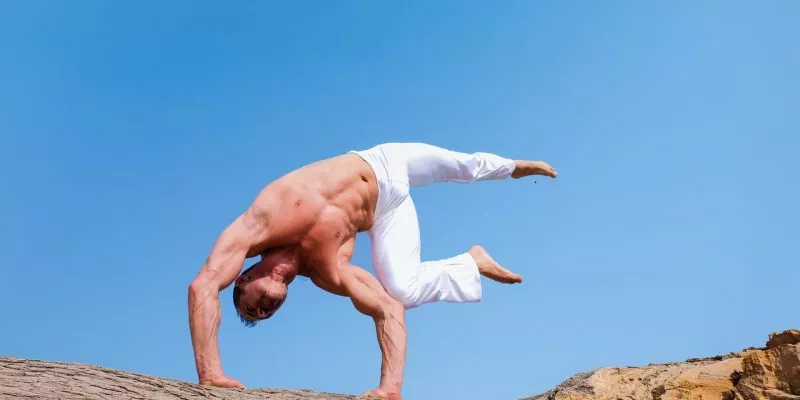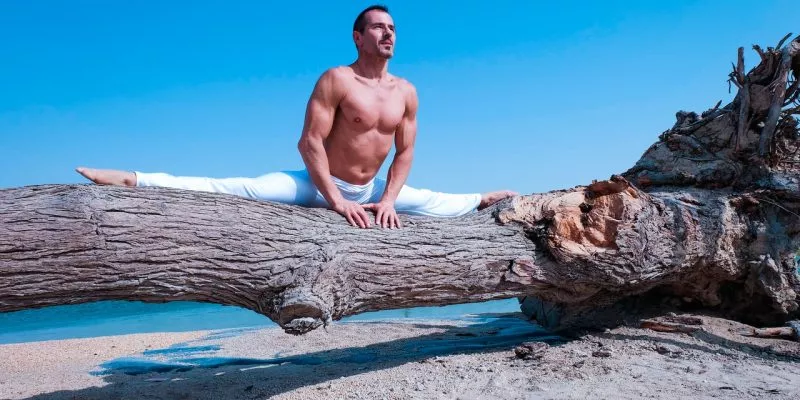Kundalini Yoga is becoming popular around the world. A century-old practice that focuses on breath control and physical posture, coupled with chanting and meditation. And it is likely to activate your full potential only when you are ready for it.
But, what is Kundalini anyway? When we read attentively, that is Kundalini. A growing tree is Kundalini. In a way, Kundalini is the fundamental life force in the existence of any being.
Kundalini is the most dangerous and potent energy source that lays dormant within the base of the spine. Harnessing this energy source requires a specific frequency of mental focus, commitment, and understanding.
There are countless yoga poses to unlock the benefits of Kundalini. Here is a list of 10 Kundalini yoga poses and their benefits.

10 Kundalini Yoga Poses and Their Benefits
Seated Cat-Cow Pose or Marjaryasana-Bitilasana
The Seated Cat-Cow pose is a simple yet beautifully energetic sequence to start the practice that improves spinal fluidity. It also stretches the abdomen, chest, hips, and legs.
In Kundalini yoga, the Seated Cat-Cow pose brings awareness to the mind and body-providing a sense of grounding towards the earth. After engaging in this pose, proceed to Kundalini Circles.
To perform Kundalini Circles, place the hands on the knees, lean the torso to the left round the back, exhale. Bring the torso to the right, shine your chest forward, inhale.
Continue this for five breath cycles then, carry on counterclockwise. Practice Marjaryasana-Bitilasana after a long period of working on the computer.
Cobra Pose or Bhujangasana
A pose that resembles a cobra ready to strike at any given time. This pose is full of potential energy and benefits to the body. It helps in developing upper spine strength and flexibility.
Like most backbends, it strengthens the back-opening the heart chakra that attributes to relationships, compassion, and emotion. If this pose is too difficult, place a rolled-up towel under the hips for support while relaxing the shoulders.
Camel Pose or Ustrasana
Ustrasana awakens multiple chakras, heart, solar plexus, crown, throat, and the third eye chakra. The Camel works by opening the chest and releasing the shoulders.
Practicing this pose can ease the pain of sciatica- inflammation of the nerve that runs from the hips to the back of the leg. Be cautious when entering Ustrasana because it may cause nausea or dizziness.
To modify the pose, widen the knees while keeping the toes to touch. From here, tuck the tailbone, then draw the navel in. Lengthen the spine by engaging the back muscles to stabilize the low back. Inhale and lift the arms. Exhale look to the right while bringing the right hand down to the heel if it's accessible. If not, use a block or books to prop up.
Bow Pose or Dhanurasana
With this high-energy pose, it's critically important to keep arms and elbows straight; and shoulders pressed down and back. It works by massaging the spine and stretching the chest, shoulders, and abdomen.
Dhanurasana increases oxygen and expels carbon dioxide from the body, which helps reduce anxiety, stress, and fatigue. It is also practical in managing diabetes and menstrual cramps because it boosts blood circulation.
Steer clear from practicing the Bow pose while experiencing hypotension or hypertension.
Frog Pose or Mandukasana
Frog pose invites the mind to find stillness and let go of obsessive thoughts. It is a fantastic Sacral chakra pose associated with the water element-symbolizing fluidity and flexibility.
The holistic benefits of the Frog pose include relieving depressive thoughts, headaches, and stress through purposeful breathing. It favors the spleen, kidney, and liver to function effectively.
There will be a sensation of tightness in the groin that has to do with inflexibility. If Mandukasana is too challenging to execute, there are many alternative variations to this pose.
Lay the chest on a pillow for support. Adjusting the hips forward to reduce the intensity while moving the hips back will increase it. Also, try the Half-Legged Frog pose and hold it for a count of three to five breath cycles. Repeat on the other side.
Crow Pose or Bakasana
Many people fear gearing up for the Crow pose. It requires proper breath control and mental focus, strength, and patience. Bakasana promotes vitality, energy, and confidence.
This Kundalini technique balances the body and the soul and frees the mind from mental clutter. Though it may seem advanced, it is easy to achieve. Don't get into this posture right away. It is apparent to warm up the body before getting into Bakasana to avoid injury.
Child’s Pose or Balasana
Turning to Balasana is an opportunity to relax and pause during an intense Kundalini yoga sequence. This pose mimics a child in the womb of its mother, ever nurturing, ever caring.
It opens two chakras; the root chakra and the third-eye chakra. Center the mind to observe the movement of the diaphragm as it takes in oxygen.
If kneeling is uncomfortable, place a rolled-up mat or towel under the ankles to alleviate any pressure on the tops of the feet. Or, set a block between the hips and heels if it feels tight. If the head doesn't reach the floor, rest the forehead on a block.

Hero Pose or Virasana
Meditating in Virasana is another excellent way to awaken the root chakra, which lies at the base of the spine. It helps strengthen the arches of the back and energizes tired legs, and it can be a therapeutic practice for pregnant women and women experiencing menopause.
Some students find Hero pose strenuous, especially those with tight hip flexors from doing everyday activities-sitting all day or playing sports. To make the experience enjoyable, use props underneath the sitting bones and pad the knees if needed.
Make sure not to splay the knees too far apart. If the hips are too tight, try the one-legged Hero pose. For a challenge, practice the reclining Hero pose. There is calming strength in Virasana that draws attention inward as the body gently lowers to the floor.
Lotus Pose or Padmasana
The lotus flower represents the whole essence of life. It manifests purity above muddy waters.
Padasana takes after the lotus flower that opens the lungs, heart, ribcage, and upper back to full consciousness. It is the most common position for meditation and pranayama or yogic breathing that revitalizes the body and promotes mental clarity.
The Lotus pose has been a hundred-old practice for a good reason. It boosts concentration and awareness through ujjayi breathing-A handy exercise to regulate stress and develop mindfulness in any situation.
Trauma usually manifests itself in the hips, and Padasana has a way for the mind to find acceptance.
Throat Lock or Jalandhara Bandha
Also known as Neck or Chin Lock, Jalandhara Bandha is a technique that compresses the neck to improve heart rate and blood flow in preparation for meditation.
In other words, it's a practice to lock and redirect the energy flow in the spine and neck to tone the thyroid glands and regulate metabolism. Impaired breathing can cause numerous problems due to excessive carbon dioxide present in the body.
To mitigate these issues, practice Jalandhara Bandha as it compresses the sinuses to regulate breathing.


